NH arts organizations ponder an uncertain future: 'We're in a very fragile state right now.'
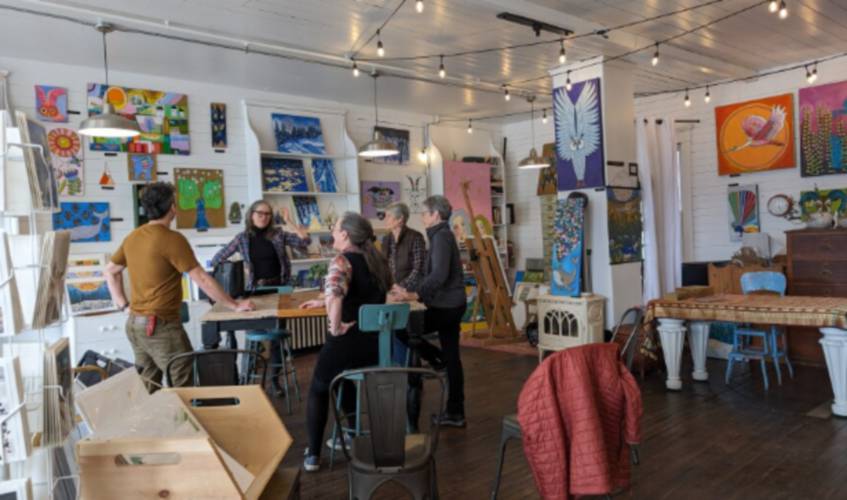
Artists gather around the community table at Three Sisters Gallery in Gorham. Olivia Richardson—NHPR
| Published: 04-10-2024 10:11 AM |
The Rochester Museum of Fine Arts sits in the old, empty hallways of a former public high school. Other tenants include an alternative education program and organizations that help people through food insecurity, human trafficking and domestic violence.
Matt Wyatt, its co-director, said when it first opened in 2011, the concept was new.
“People kind of laughed at us at first,” Wyatt said.
Wyatt acknowledges it’s an unconventional setting for the textiles, sculptures and other works of art now filling the hallways. But it’s ended up being a real strength for the museum.
“We've survived because this model works and it is sustainable, because we're in a public building,” Wyatt said. “We don't have any bills. So every dollar that we're able to raise goes right back into the community in the form of public art or framing or paint on an empty wall, whatever it might be.”
Wyatt and Amy Regan, the museum’s other co-director, are also volunteers, sparing additional staffing costs. They also help with other galleries, on top of making their own art.
Across the state, other arts organizations aren’t feeling quite as stable. The last few months have seen a wave of tough news for the arts in New Hampshire: staff cuts at Kimball Jenkins in Concord, plus the closures of the University of New Hampshire Museum of Art and MONA Portsmouth, to name a few.
Those who remain open say they’re struggling to chart a path forward as the relief money that helped to sustain them during the pandemic dries up. And lately, they’re often competing for grants and other funding against programs that focus on housing, food and other basic needs.
Article continues after...
Yesterday's Most Read Articles
 Hometown Heroes: Couple’s sunflower fields in Concord reconnects the community to farming
Hometown Heroes: Couple’s sunflower fields in Concord reconnects the community to farming
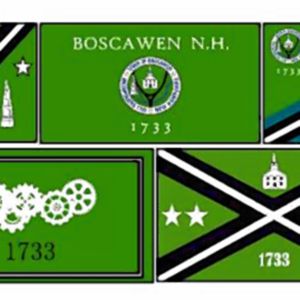 Boscawen resident takes issue with proposed town flag designs
Boscawen resident takes issue with proposed town flag designs
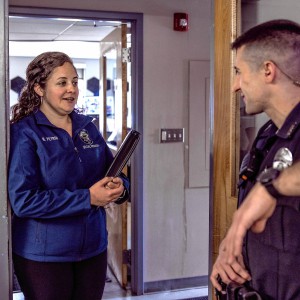 Skepticism turns to enthusiasm: Concord Police welcome new social worker
Skepticism turns to enthusiasm: Concord Police welcome new social worker
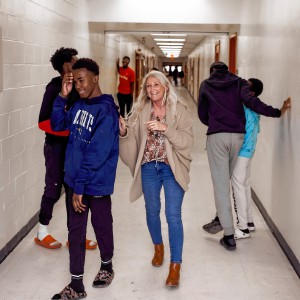 With new plan for multi-language learners, Concord School District shifts support for New American students
With new plan for multi-language learners, Concord School District shifts support for New American students
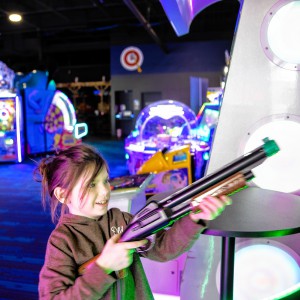 With Concord down to one movie theater, is there a future to cinema-going?
With Concord down to one movie theater, is there a future to cinema-going?
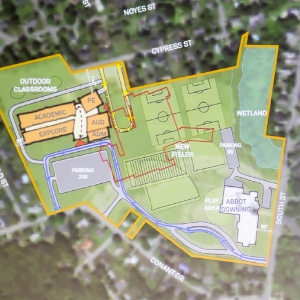 Opinion: The Concord School Board can restore trust with residents
Opinion: The Concord School Board can restore trust with residents
But some in New Hampshire’s art scene say they’re also facing more existential challenges: trying to stay relevant and accessible to a wider audience while still staying afloat, financially.
In Gorham, Deidre Blair, a longtime painter, found herself at a crossroads after the restaurant where she worked as a bartender shut down during the pandemic. The local makerspace in town also went under during COVID, and she knew fellow artists could use a new place to make connections and showcase their work.
In 2021, she opened Three Sisters Gallery, which now hosts about 20 artists — from photographers to sculptors to candle makers. She’s trying to defy stereotypes that all galleries are stuffy, elitist and hands off.
“I can’t tell you how many times parents walk by and go ‘we can’t go in there you can’t touch anything’ and I go ‘YOU CAN TOUCH THINGS!'” Blair said, drawing laughter from other artists gathered in her space that day.
But running the business has its challenges. Blair said there’s too much talent in the North Country to put on display, so she’s often turning people away.
She also knows it’s not uncommon for local artists to work multiple jobs to make ends meet. She tries to offer a more generous profit-sharing model: charging a 20% commission rate on works sold at her gallery, whereas some other places can charge 40% or more. But that also means less money to help with operating costs.
“I run this place by myself, and I also have two other jobs,” Blair said. “And I don't have time to fill out, like, grant applications and then check in.”
At the Currier Museum of Art in Manchester, Director Bruce McColl said they’re in an enviable position. They’ve been around for nearly 100 years; they have a steady stream of corporate funding, a supportive board and an established reputation locally. But it’s been hard to see their friends and other arts institutions struggling.
“I do think we're in a very fragile state right now,” McColl said. “We're post-COVID, federal funds have dried up to a large extent. And nonprofits, especially arts organizations of all sizes, are feeling the impact.”
As the Currier looks to its future, it’s also not without its own challenges. Senior Curator Kurt Sundstrom said they’re looking to shed their reputation as a place where only certain kinds of art or artists are welcome.
“When I came here, it's hard to say this, but 25 years ago there wasn't a single African American artist represented in this collection,” he said. “So if you want to give a story of America and exclude everyone of color and only let white males tell the story, it's a pretty boring story — and it's a pretty slanted story.”
Sundstrom said they’ve worked to diversify their exhibits. But they’re also trying to open up the museum in other ways: hosting art programs for veterans and summer block parties that feature local artists’ works making it a place where literally anyone can envision themselves, a far cry from the museum’s history as a place where elites gathered for high tea.
“It was not a place for everybody,” Sundstrom said. “And we want to make it a place for everybody.”
Manchester artist Randall Nielsen said other institutions should take note.
“Arts programming that is in New Hampshire has been pretty stagnant in what they're offering and how they're engaging the community,” he said.
Nielsen leads Queerlective, an organization focused on uplifting LGBTQ+ creatives in New Hampshire. So far, he said, the community has responded positively, and attendance at their events has been strong.
When Nielsen started looking at who was in charge at other local arts organizations, he noticed that a lot of the executives and board members had a similar profile: white, older and from business backgrounds.
With that in mind, Queerlective has been offering training on the ins and outs of nonprofit boards, to try to bring more diversity to those seats of power.
“We're really also hoping for that to empower individuals in the community to join other boards and help make decisions for those organizations as well,” he said.
Making the boards of these institutions more open and inclusive, Nielsen said, could help make the institutions themselves more welcoming, too.


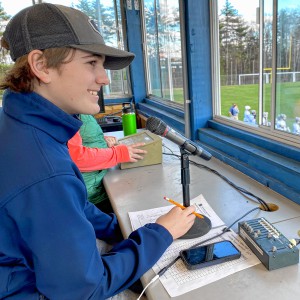 Voice of the Pride: Merrimack Valley sophomore Nick Gelinas never misses a game
Voice of the Pride: Merrimack Valley sophomore Nick Gelinas never misses a game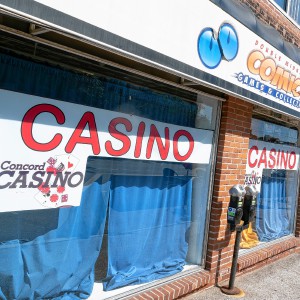 With less than three months left, Concord Casino hasn’t found a buyer
With less than three months left, Concord Casino hasn’t found a buyer Kearsarge Middle School drone team headed to West Virginia competition
Kearsarge Middle School drone team headed to West Virginia competition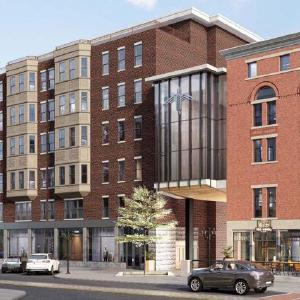 Phenix Hall, Christ the King food pantry, rail trail on Concord planning board’s agenda
Phenix Hall, Christ the King food pantry, rail trail on Concord planning board’s agenda
